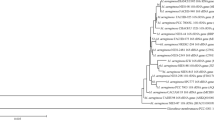Abstract
Extracellular polypeptides released by both N2-grown [peptide I] and NO3-grown [peptide II]Anabaena L-31 have molecular weight of approximately 3,500 but have distinctly different amino acid composition. Acid hydrolysis of the peptide I fraction (obtained by separation on Sephadex G-25) yielded ten amino acids whereas that from peptide II fraction yielded only 3 amino acids. On addition to a freshly inoculated N2-grown culture, the peptide I fraction stimulated pro-heterocyst and to a lesser extent heterocyst differentiation, whereas the peptide II fraction strongly inhibited differentiation. The inhibitory effect of polypeptide II fraction could not be relieved by methionine sulphoximine, which by itself enhances differentiation, but was greatly relieved by addition of the peptide I fraction. The data suggest but does not prove, thatAnabaena L-31 synthesises “inducer” or “inhibitor” peptides which could possibly control pattern formation.
Similar content being viewed by others
References
Agrawal, M. and Kumar, H. D. (1978)Proc. Indian Acad. Sci.,B87, 31.
Bradley, S. and Carr, N. G. (1976)J. Gen. Microbiol.,96, 175.
Bradley, S. and Carr, N. G. (1977)J. Gen. Microbiol.,101, 291.
David, K. A. V. and Thomas, J. (1972) inProceedings of the symposium on cellular processes in growth, development and differentiation, Bombay, Department of Atomic Energy, Government of India, p. 413.
Fay, P., Kumar, H. D. and Fogg, G. E. (1964)J. Gen. Microbiol.,35, 351.
Fogg, G. E. (1944)New Phytol.,43, 164.
Fogg, G. E. (1949)Ann. Bot. N.S.,13, 241.
Fogg, G. E. (1952)Proc. R. Soc. (London) B139, 372.
Jakob, H. (1954)CR Acad. Sci. Paris,238, 2018.
Jakob, H. (1957)CR Acad. Sci. Paris,244, 1968.
Katz, E. and Demain, G. (1977)Bacteriol. Rev.,41, 449.
Kulasooriya, S. A., Lang, N. J. and Fay, P. (1972)Proc., R. Soc. (London) B181, 199.
Mackinney, G. (1941)J. Biol. Chem.,140, 315.
Mickelson, J. C., Davis, E. B. and Tischer, R. G. (1967)J. Exp. Bot.,18, 397.
Mitchison, G. J. and Wilcox, M. (1973)Nature (London) New Biol.,246, 229.
Ogawa, R. E. and Carr, J. E. (1969)Limnol. Oceanogr.,14, 342.
Payne, J. W. (1976)Adv. Micro. Physiol.,13, 55.
Stewart, W. D. P. (1964)J. Exp. Bot.,15, 138.
Stewart, W. D. P. and Rowell, P. (1975)Biochem. Biophys. Res. Commun.,65, 846.
Steyermark, A. (1961) inQuantitative organic microanalysis, ed. A. Steyermark (London: Academic Press) p. 188.
Talpasayi, E. R. S. and Kale, K. S. (1967)Curr. Sci.,36, 218.
Thomas, J. and David, K. A. V. (1971)J. Gen. Microbiol.,66, 127.
Thomas, J. and David, K. A. V. (1972)Nature (London)New Biol.,238, 219.
Thomas, J., Meeks, J. C., Wolk, C. P., Shaffer, P. W., Austin, S. M. and Chien, W. S. (1977)J. Bacteriol.,129, 1545.
Walsby, A. E. (1974)Br. Phycol. J.,9, 317.
Whitton, B. A. (1965)J. Gen. Microbiol.,40, 1.
Wilcox, M., Mitchison, G J and Smith, R. J. (1973a)J. Cell Sci.,12, 707.
Wilcox, M., Mitchison, G. J. and Smith, R. J. (1973b)J. Cell Sci.,13, 637.
Wolk, C. P. (1967)Proc. Natl. Acad. Sci. USA,57, 1246.
Wolk, C. P. (1975) inSpores VI (Washington D.C.: Am. Soc. for Microbiology), p. 85.
Wolk, C. P. and Quine, M. P. (1975)Dev. Biol.,46, 370.
Author information
Authors and Affiliations
Rights and permissions
About this article
Cite this article
David, K.A.V., Thomas, J. Extracellular polypeptides ofAnabaena L-31: Evidence for their role in regulation of heterocyst formation. J Biosci 1, 447–455 (1979). https://doi.org/10.1007/BF02704627
Received:
Revised:
Issue Date:
DOI: https://doi.org/10.1007/BF02704627




